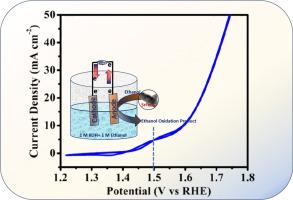揭示SrFeO3纳米板在碱性乙醇氧化反应中的氧化还原驱动效率
IF 5.7
3区 材料科学
Q2 MATERIALS SCIENCE, MULTIDISCIPLINARY
引用次数: 0
摘要
乙醇燃料直接酒精燃料电池(DAFCs)代表了一种高效、环保的可再生能源技术解决方案。然而,传统的DAFC系统通常依赖于昂贵的贵金属电催化剂,如Pt和Pd,它们在乙醇氧化过程中容易受到CO中毒。钙钛矿氧化物由于其可调节的结构、低成本和固有的电催化活性而成为有前途的替代品。在这项研究中,我们报道了钙钛矿基电催化剂锶铁氧体(SrFeO3)的溶胶-凝胶合成,用于DAFC。合成的SrFeO3在1.50 V下的峰值电流密度为4.83 mA cm−2,具有良好的CO容差(容差系数≈1.16)。优异的电催化性能归因于铁的异常氧化,导致氧空位和提高乙醇的有效氧化。这些发现强调了钙钛矿基催化剂作为酒精燃料电池耐用、低成本替代品的潜力,并推动了可持续能源解决方案的发展。本文章由计算机程序翻译,如有差异,请以英文原文为准。

Unveiling the redox-driven efficiency of SrFeO3 nanoplates in alkaline ethanol oxidation reactions
Ethanol-fueled direct alcohol fuel cells (DAFCs) represent an efficient and environmentally friendly solution for advancing renewable energy technologies. Conventional DAFC systems, however, often depend on expensive noble metal electrocatalysts such as Pt and Pd, which are vulnerable to CO poisoning during ethanol oxidation. Perovskite oxides have emerged as promising alternatives due to their adjustable structures, low cost, and intrinsic electrocatalytic activity. In this study, we report the sol-gel synthesis of strontium ferrite (SrFeO3), a perovskite-based electrocatalyst, for DAFC applications. The synthesized SrFeO3 achieves a peak current density of 4.83 mA cm−2 at 1.50 V and demonstrates robust CO tolerance (tolerance factor ≈ 1.16). The excellent electrocatalytic performance is attributed to the presence of unusual oxidation of iron, which leads to oxygen vacancy and boost efficient ethanol oxidation. These findings underscore the potential of perovskite-based catalysts as durable, low-cost alternatives for alcohol fuel cells and advance the development of sustainable energy solutions.
求助全文
通过发布文献求助,成功后即可免费获取论文全文。
去求助
来源期刊

Materials Research Bulletin
工程技术-材料科学:综合
CiteScore
9.80
自引率
5.60%
发文量
372
审稿时长
42 days
期刊介绍:
Materials Research Bulletin is an international journal reporting high-impact research on processing-structure-property relationships in functional materials and nanomaterials with interesting electronic, magnetic, optical, thermal, mechanical or catalytic properties. Papers purely on thermodynamics or theoretical calculations (e.g., density functional theory) do not fall within the scope of the journal unless they also demonstrate a clear link to physical properties. Topics covered include functional materials (e.g., dielectrics, pyroelectrics, piezoelectrics, ferroelectrics, relaxors, thermoelectrics, etc.); electrochemistry and solid-state ionics (e.g., photovoltaics, batteries, sensors, and fuel cells); nanomaterials, graphene, and nanocomposites; luminescence and photocatalysis; crystal-structure and defect-structure analysis; novel electronics; non-crystalline solids; flexible electronics; protein-material interactions; and polymeric ion-exchange membranes.
 求助内容:
求助内容: 应助结果提醒方式:
应助结果提醒方式:


